Products You May Like
Get access to everything we publish when you
sign up for Outside+.
If you’re looking for an escape from city life, Shenandoah National Park is it. Though just 75 miles from the bustling metropolis of Washington, D.C., Shenandoah is 40% designated wilderness, and this hiking haven in the Blue Mountains has a bit of everything—forested valleys, hidden waterfalls, open summit vistas. It’s a great destination year-round, too. Whether you’re looking for roaring cascades in the spring, water holes in the summer, bright red and gold leaves in the fall, or endless views from between the bare tree branches in the winter, Shenandoah has a hike for you.
The Best Dayhikes in Shenandoah National Park
You can see top-notch natural wonders in Shenandoah even if you only have one day away from the city. Alternatively, tackle a few of these top dayhikes from the luxury of a car-camping base at one of the park’s five campgrounds.
A Bit of Everything: Riprap Trail

Want it all? Try the Riprap Trail. Located in southern Shenandoah National Park, this 9.1-mile loop–with optional Appalachian Trail extension–highlights the park’s two best features. Start at the Riprap Trail parking area off of Skyline Drive, tracking the AT south. Turn right onto Wildcat Ridge and descend 1,500 feet. Turn right onto the Riprap Trail and ahead pass the park’s largest swimming holes and a temple of cliffs called Calvary and Chimney Rocks. Continue on Riprap to the AT. Turn right and close loop at car. Optional: To tag a peak, take the AT south to 2,981-foot Turk Mountain, adding six out-and-back miles to the circuit. —Backpacker Magazine
Wildlife Haven: Turk Branch Trail
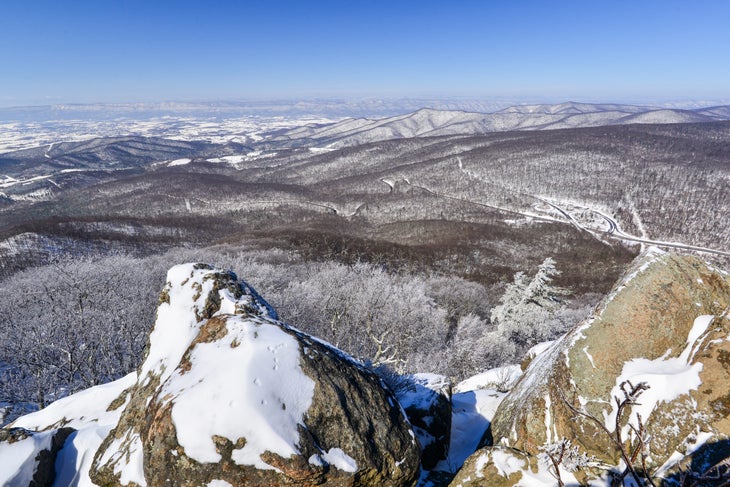
This 4-mile out-and-back passes an old homestead and a lively mountain stream as it winds through mountain laurel and red oak. These woods are more popular with deer, black bears, and bobcats than hikers; take advantage of the solitude to spot some of the elusive wildlife. In spring and summer, dogwood and wild geraniums flower all along the route, and in the fall the foliage turns startling shades of red, orange, and gold. Winter wins for views, though: With the leaves gone, you can see the slopes and summit of Turk Mountain.
The Classic Shenandoah Hike: Old Rag Mountain
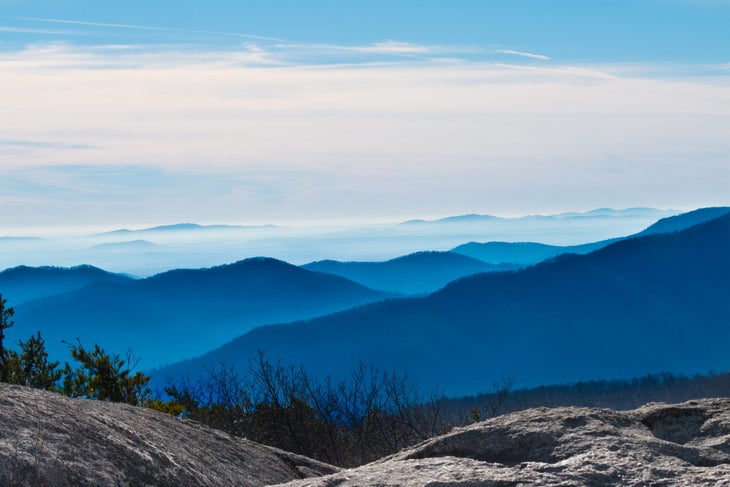
Weaving around car-size boulders to the summit of 3,268-foot Old Rag Mountain is the quintessential Shenandoah thrill–and its airy precipice is also the best place for 360-degree views (especially for leaf-peeping in early November). But unknown it is not, so pack a headlamp and set out on this 8.6-mile circuit three hours before sunset to enjoy a crowd-free summit. Take the Ridge Trail up shady switchbacks to an open ridgeline and two miles of scrambling to the Big Whoa–a sweeping panorama of mountainsides. Descend via the Saddle Trail and Weakley Hollow Fire Road to close the loop. —Backpacker Magazine
The Best Weekend Hikes in Shenandoah National Park
Ready to escape to the mountain backcountry for a whole weekend? With a couple of days off, you can string together waterfalls, river gorges, and ridgelines into a trip you won’t forget any time soon.
Best for Waterfalls: Hazel Mountain
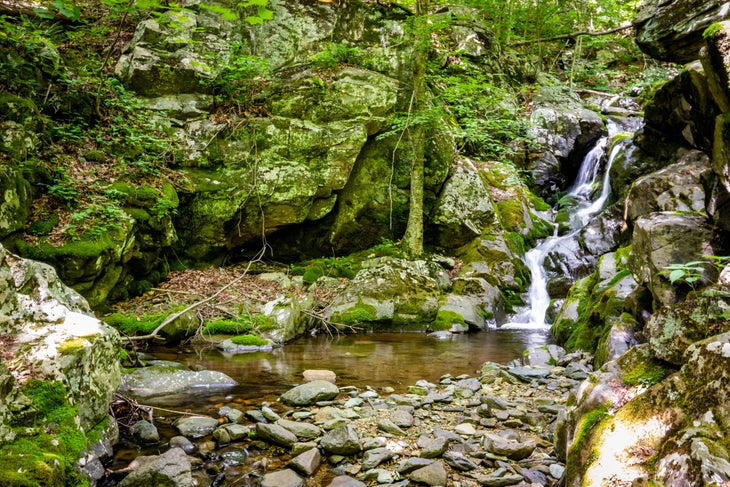
This 9.2-mile loop is an easy one-night backpack when you just have a weekend to get away. Starting in thick deciduous forest, the trail winds to the Hazel River, then heads towards the first of four waterfalls along the route, Cave Falls, which has shallow caverns to explore as well as a gently sloping cascade between the boulders. Past the falls, link up with the Hazel Mountain Trail to climb a forested ridgeline with views (especially good in the winter, when all the leaves have fallen) of the hills and valleys of the Blue Ridge Mountains spreading out all around. The best campsites are where the White Rocks Trail meets the Hazel River, with some good, flat tent sites that have easy access to the water.
Ridgelines and Rivers: Matthews Arm Loop
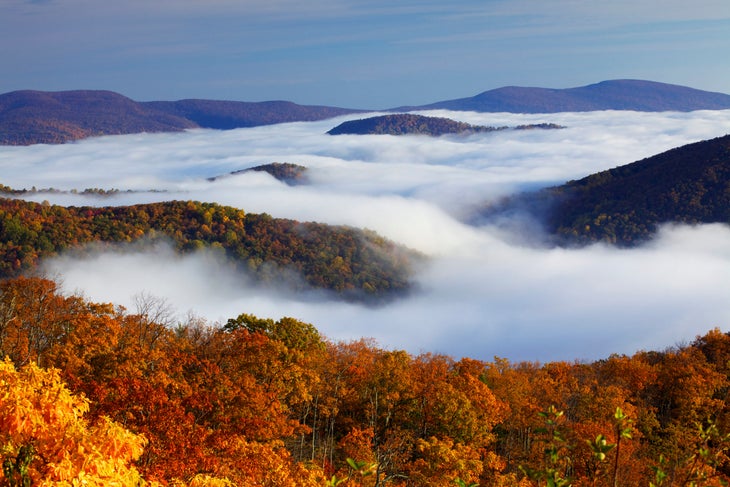
This 16.8-mile loop serves up a weekend classic: waterfall-filled hollows, lush forests, and gorgeous backcountry campsites. Start on the AT before heading to the Pole Bridge Link Trail, beneath a canopy of maple and ash that burn crimson and orange in October. From there begin the rocky 1,200-foot descent down Keyser Run, preparing for wide and slippery crossings of the stream pouring into the narrow gorge. Trace the western base of 2,531-foot Pignut Mountain crossing Piney River, then meander into the narrowing granite walls of Thornton River’s Canyon. Camp in a sheltered glade just after exiting the gorge.
Next day, hike up the Blue Ridge, cross Skyline Drive, and stay left on the Thornton River Trail. Turn right onto the AT, and climb the wooded ridgeline for two miles. Head left onto Elkwallow Trail and begin the sharp climb up Jeremy’s Run. At Mathews Arm Campground, cross the road to pick up Mathews Arm Trail. Climb the Tuscarora Trail, and power 500 feet up the western ridge of Hogback Mountain. Head left on the AT to the trailhead. —Alex Geller and Sarah L. Stewart
The Best Multiday Hike in Shenandoah National Park
If you have the time and the desire to go on a long—really long—walk, Shenandoah has you covered. Luckily, Shenandoah has plenty of wilderness trails to link together a multiday escape.
Views, Views, and More Views: The Appalachian Trail
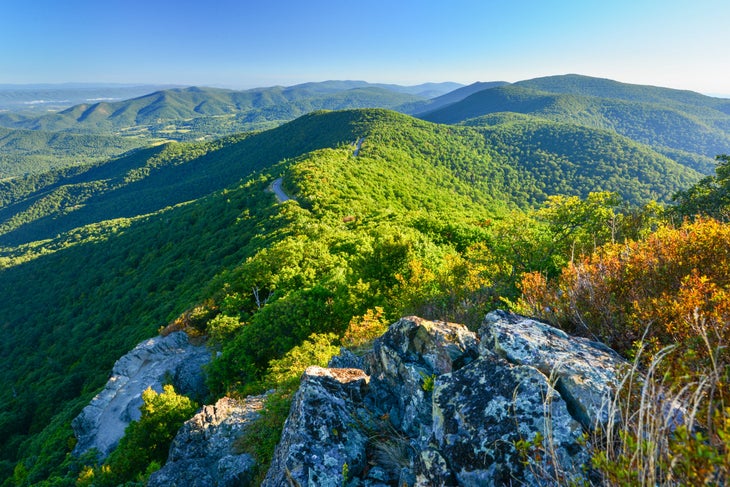
There are over 100 miles of the AT in and around Shenandoah National Park, and more than a few of them run the crests of peaks and ridgelines with 360-degree panoramas of the lush valleys and forested peaks of the Blue Ridge Mountains. Most hikers take about a week to do the whole section (best avoided in July and August, when all the campsites are taken by thru-hikers), but you can extend your stay with side trips along connecting trails or speed through it for your own personal FKT. Highlights include extensive summit vistas at The Pinnacle and the iconic overhanging clifftop nearby at McAffee Knob.
See Wildlife: Shenandoah Salamander
This endangered, finger-length amphibian lives exclusively in moist soil under rocks and forest debris on the talus slopes of Shenandoah’s Pinnacles, Stony Man, and Hawksbill Mountains. Scientists don’t know how many individuals inhabit this tiny range, which includes a similar-looking, more common—and competing—relative, the red-backed salamander. Both sport a yellowish-red stripe on their backs, but the Shenandoah’s is much narrower—just one-third of its body width. As a member of the lungless salamanders, this tiny critter breathes through its skin. —Alex Geller and Sarah L. Stewart
When to Visit Shenandoah National Park
Trails in Shenandoah are open year-round, but fall is best for colors (most of the park’s forest is deciduous) and winter is best for solitude, though you’ll need beefier gear for the cold temps. Summer has the mildest weather, but it’s also the busiest; most backcountry sites along the park’s AT section will also be filled with thru-hikers in July and August, so plan your campsites around the migration.
